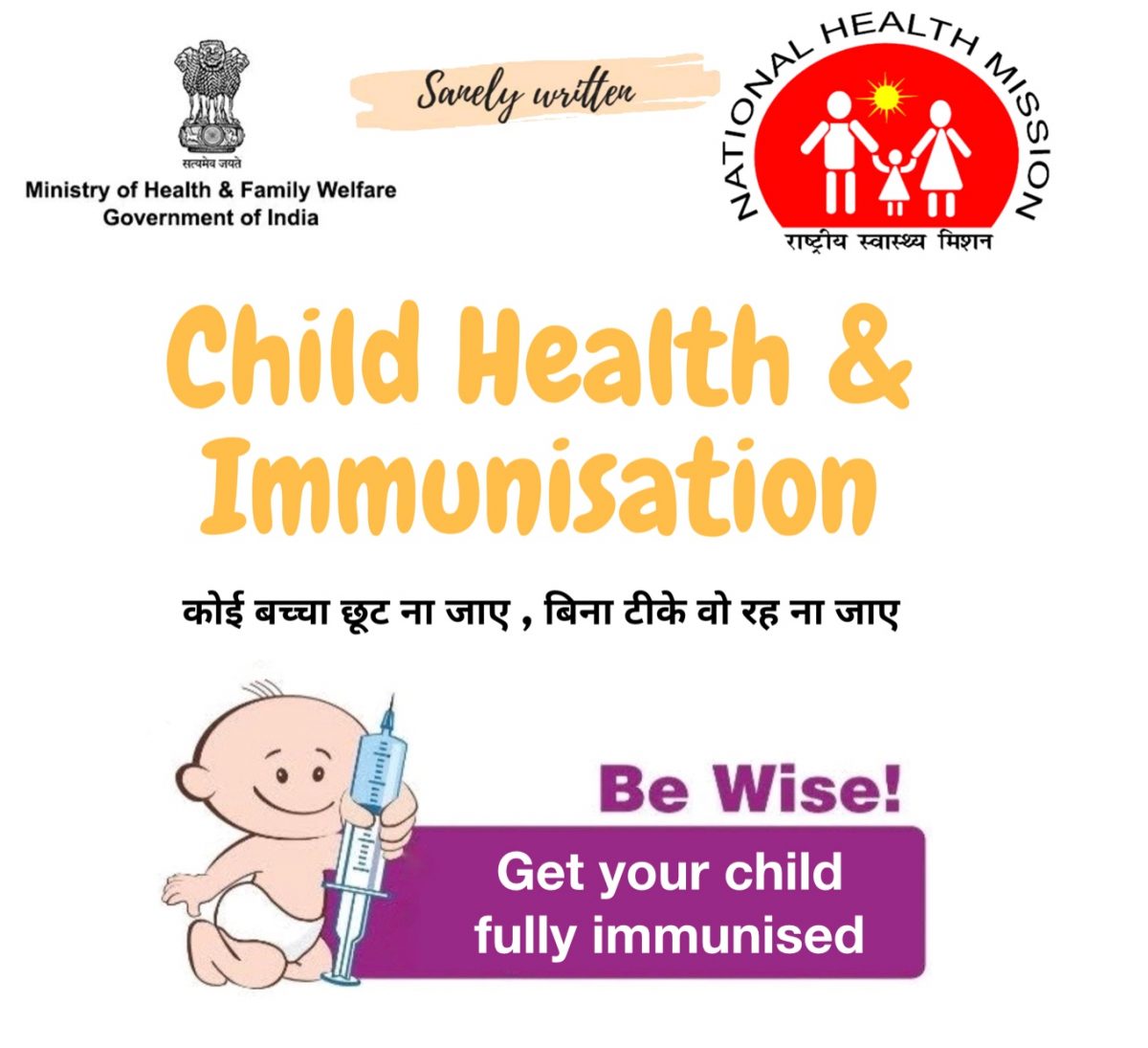Seeing your baby for the first time is a priceless moment. There is a gamut of emotions that every parent goes through from love and happiness to sheer wonder. But the most overpowering feeling that every parent experiences is a fierce sense of protectiveness of the young life that has been entrusted to their care.
It’s hard not to constantly worry about keeping your baby safe. After all, they look so small and fragile, while the world around them appears so risky and dangerous. There are several things we do in the name of safety. We install a special seat in our car, baby proof our home, switch to natural products and so much more. But what about protection from infections, diseases, and other ailments? This is where immunisation comes into the picture.
Immunisation is a key component of primary health care and an indisputable human right. It’s also one of the best health investments money can buy.
Immunisation Programme in India was introduced in 1978 as the ‘Expanded Programme of Immunisation’ (EPI) by the Ministry of Health and Family Welfare, Government of India. In 1985, the programme was modified as the ‘Universal Immunisation Programme’ (UIP) to be implemented in a phased manner to cover all districts in the country by 1989-90 with one of the largest health programme in the world. Despite being operational for many years, UIP has been able to fully immunize only 65% of children in the first year of their life.
Through UIP, the Government of India is providing vaccination free of cost against vaccine-preventable diseases including diphtheria, pertussis, tetanus, polio, measles, a severe form of childhood tuberculosis, hepatitis B, meningitis and pneumonia (Hemophilus influenza type B infections), Japanese encephalitis (JE) in JE endemic districts with the introduction of newer vaccines such as rotavirus vaccine, IPV, adult JE vaccine, pneumococcal conjugate vaccine (PCV) and measles-rubella (MR) vaccine in UIP/national immunisation programme.
Mission Indradhanush
To strengthen and re-energize the programme and achieve full immunisation coverage for all children and pregnant women at a rapid pace, the Government of India launched “Mission Indradhanush” in December 2014.
Goals of Mission Indradhanush:
The ultimate goal of Mission Indradhanush is to ensure full immunisation with all available vaccines for children up to two years of age and pregnant women. The Government has identified 201 high focus districts across 28 states in the country that have the highest number of partially immunised and unimmunised children.
Earlier the increase in full immunisation coverage was 1% per year which has increased to 6.7% per year through the first two phases of Mission Indradhanush. Four phases of Mission Indradhanush have been conducted till August 2017 and more than 2.53 crore children and 68 lakh pregnant women have been vaccinated.
Intensified Mission Indradhanush (IMI)
To further intensify the immunisation programme, Prime Minister Shri Narendra Modi launched the Intensified Mission Indradhanush (IMI) on October 8, 2017. Through this programme, the Government of India aims to reach each child up to two years of age and all those pregnant women who have been left uncovered under the routine immunisation programme/UIP. The focus of the special drive was to improve immunisation coverage in selected districts and cities to ensure full immunisation to more than 90% by December 2018.
Under IMI, four consecutive immunisation rounds were conducted for 7 days in 173 districts (121 districts and 17 cities in 16 states and 52 districts in 8 northeastern states) every month between October 2017 and January 2018. Intensified Mission Indradhanush has covered low performing areas in the selected districts (high priority districts) and urban areas. Special attention was given to unserved/low coverage pockets in sub-centre and urban slums with the migratory population. The focus was also on the urban settlements and cities identified under the National Urban Health Mission (NUHM).
Intensified Mission Indradhanush (IMI) 2.0
To boost the routine immunisation coverage in the country, the Government of India has introduced Intensified Mission Indradhanush 2.0 to ensure reaching the unreached with all available vaccines and accelerate the coverage of children and pregnant women in the identified districts and blocks from December 2019-March 2020.
The IMI 2.0 aims to achieve targets of full immunisation coverage in 272 districts in 27 states and at the block level (652 blocks) in Uttar Pradesh and Bihar among hard-to-reach and tribal populations.
With the launch of Intensified Mission Indradhanush 2.0, India has the opportunity to achieve further reductions in deaths among children under five years of age, and achieve the Sustainable Development Goal of ending preventable child deaths by 2030.
Several ministries, including the Ministry of Women and Child Development, Panchayati Raj, Ministry of Urban Development, Ministry of Youth Affairs, and others have come together to make the mission a resounding success and support the central government in ensuring the benefits of vaccines reach the last mile.
The salient features of IMI 2.0 are:
- Conduction of four rounds of immunisation activity over 7 working days excluding the RI days, Sundays, and holidays.
- Enhanced immunisation sessions with flexible timing, mobile session, and mobilisation by other departments.
- Enhanced focus on left-outs, dropouts, and resistant families, and hard to reach areas.
- Focus on urban, underserved populations and tribal areas.
- Inter-ministerial and inter-departmental coordination.
- Enhance political, administrative, and financial commitment, through advocacy.
- IMI 2.0 drive is being conducted in the selected districts and urban cities between Dec 2019 – March 2020
A portal named Intensified Mission Indradhanush 2.0 has been designed to manage the data reporting by different ministries/ departments, and to capture pre-campaign activities, activities during immunisation rounds, and post-campaign indicators on immunisation coverage. The latest coverage report available is as follows-
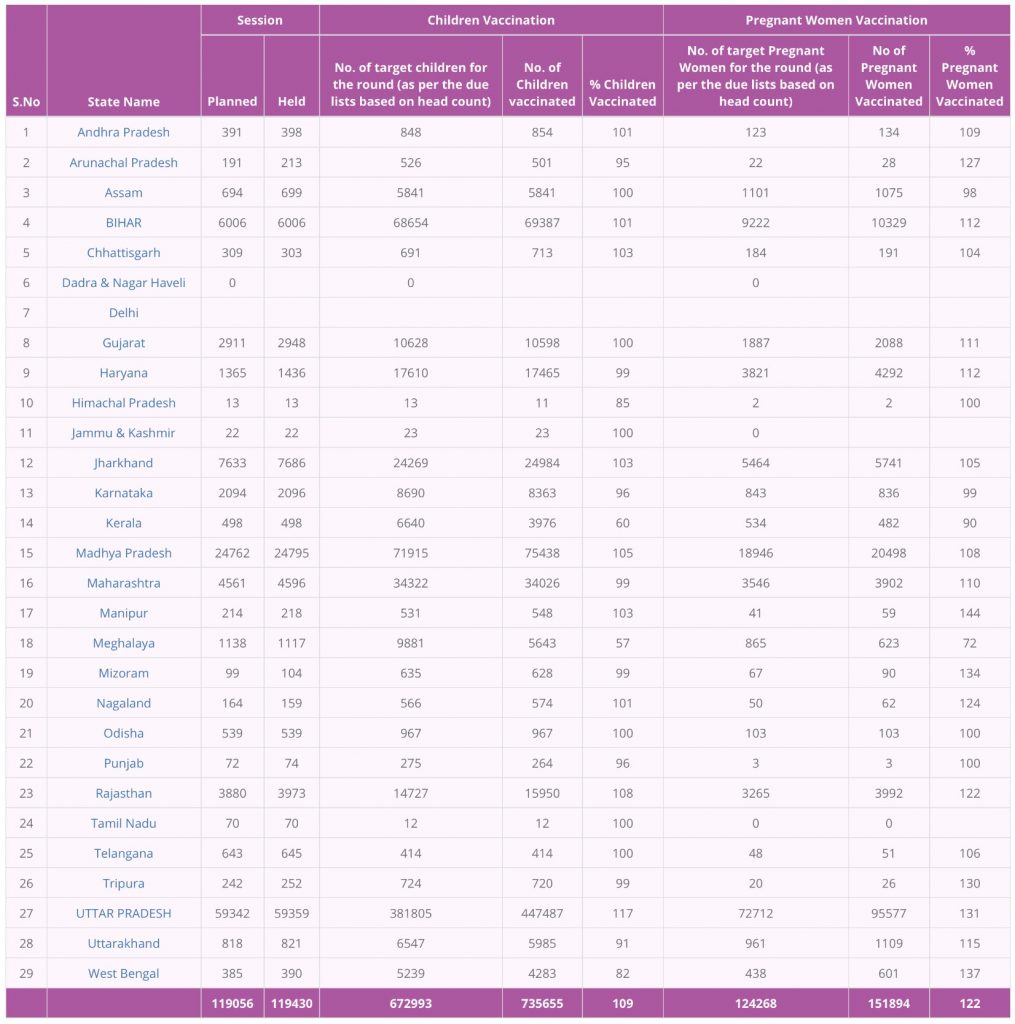
All you need to know –
What is meant by Immunisation?
Immunisation is the process whereby a person is made immune or resistant to an infectious disease, typically by the administration of a vaccine.
What are the vaccines?
Any biological preparation that possesses antigenicity (ability to elicit an immune response) but lacks pathogenicity (ability to cause disease) can be termed as a vaccine. Vaccines stimulate the body’s immune system to protect the person against subsequent infection or disease.
Where can I get my child vaccinated?
The government has ensured an elaborate mechanism to immunise all children under NIS in India. The vaccines are not only given free but delivered near to the community through the peripheral health workers, auxiliary nurse midwife/village health nurses. Services can be availed at any level of healthcare infrastructure including the villages, primary healthcare center, community healthcare center, district hospitals, private hospitals, etc.
Which vaccines are given to children and at what age?
The National Immunisation Schedule under the Universal Immunisation Programme is as follows-
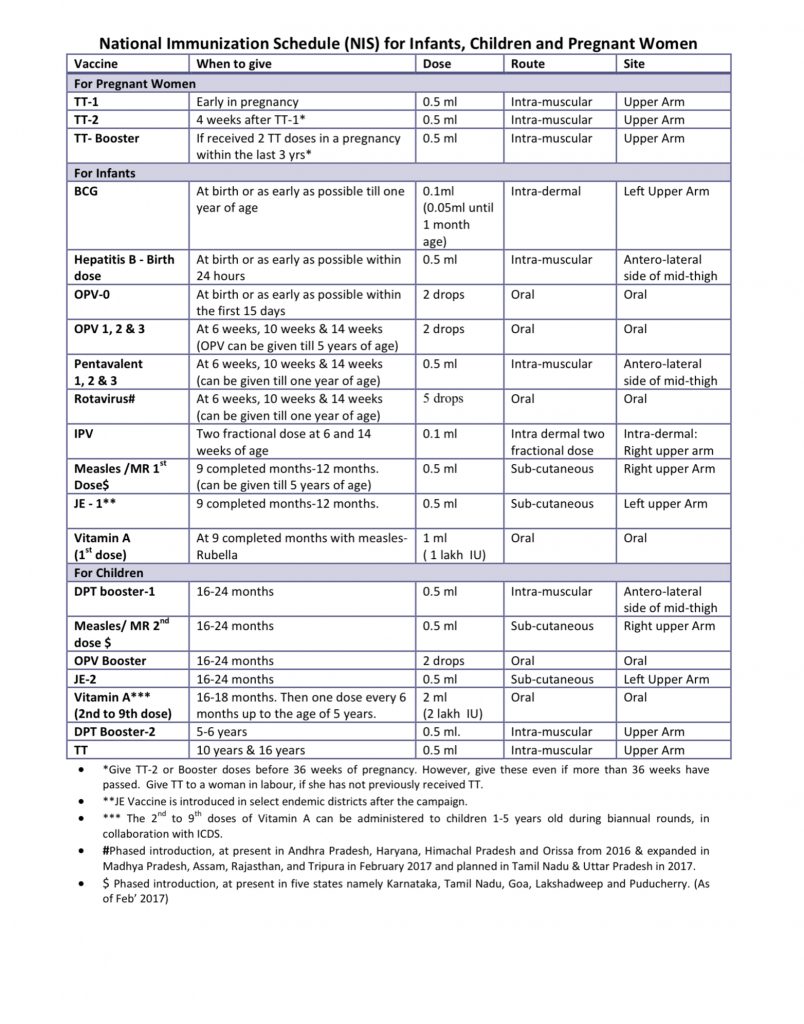
What is the minimum desirable time interval between two doses of any vaccine?
Four weeks.
Why is the vaccine given at a particular site and side of the body?
To maintain the uniformity.
How do I keep track of my child’s immunisation schedule?
For the vaccines administered under National Immunisation Schedule (NIS), a record is maintained, one copy of which is given to the mother, and ANM/ASHA/Anganwadi worker (AWW) keeps the counterfoil. It helps in follow-up and monitoring. In some states, it is a part of the Mother and Child Protection (MCP) card, whereas, in other states, it is a separate record.
Following is the immunisation section of the Mother and Child Protection (MCP) card as issued by the Ministry of Health and Family Welfare & the Ministry of Women and Child Development –
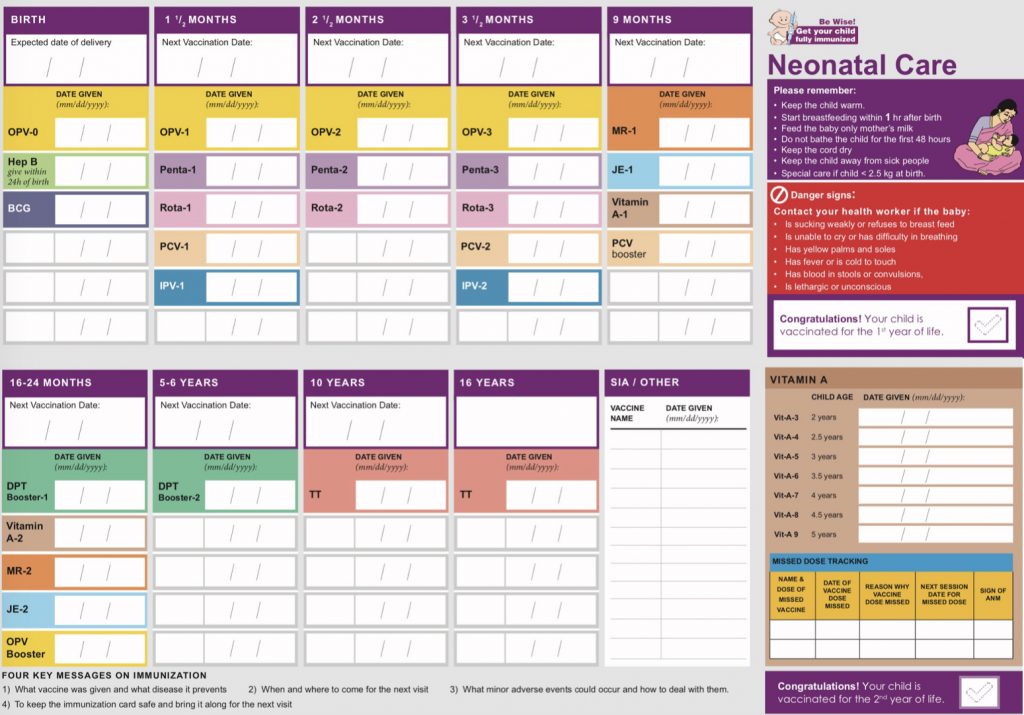
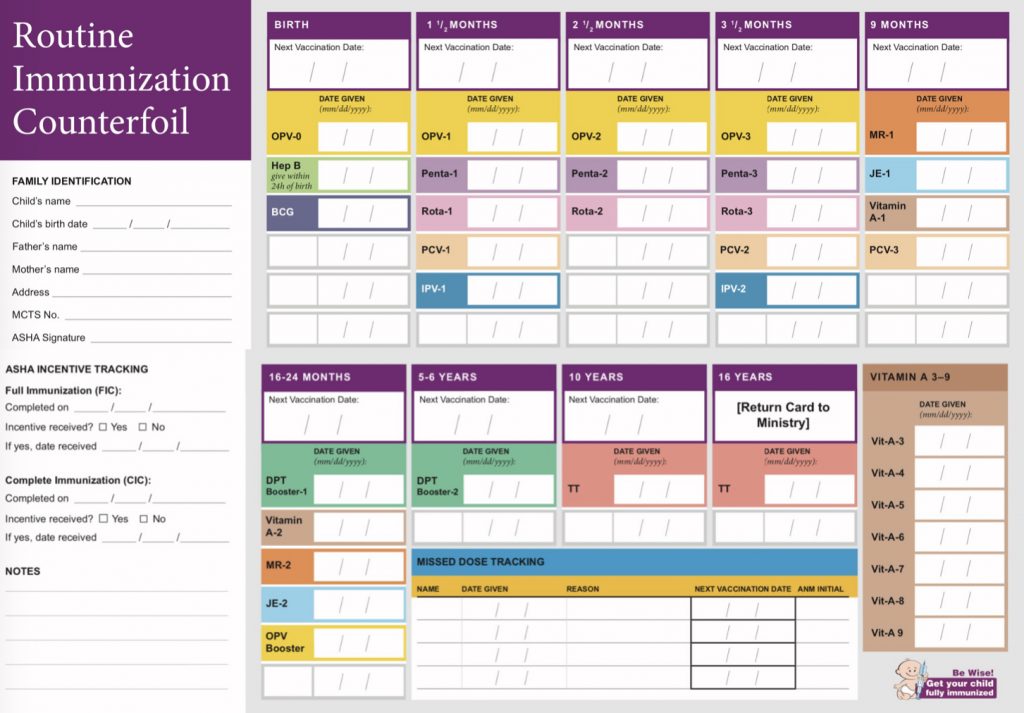
What is cold chain?
Vaccines are heat sensitive and can become ineffective if not stored and transported at an appropriate temperature range. Cold Chain is a system of storing and transporting vaccines at the recommended temperature range from the point of manufacture to point of use. India has built a vast cold chain infrastructure to ensure that only potent and effective vaccines reach millions of beneficiaries across the country. The vaccines are supplied by manufacturers directly to four Government Medical Store Depots (at Karnal, Mumbai, Chennai, and Kolkata) and state and regional vaccine stores. The GMSDs supply to the states and regional vaccine stores; state and regional vaccine stores supply vaccines to Divisional vaccine stores and districts. The vaccines are further supplied to last cold chain points which are usually situated in Primary Health Centers (PHCs) and Community Health Centers. Vaccines carriers with icepacks are used to transport vaccines from PHCs to the outreach sessions in the village. The performance and efficiency of the cold chain system at different levels are monitored continuously, through supervisory visits, review meetings. The Government of India procures and supplies all UIP vaccines along with diluents to all states. In addition to vaccines, syringes of different capacities, are also procured centrally and supplied to states.

What is Vaccine Vial Monitor?
VVM is a colour monitor label used over vaccine vials to see the effect of temperature on the vaccine. It monitors the cumulative heat exposure over time.

Common myths –
- One should stick to the same pediatrician during the entire vaccination schedule.
- The vaccination schedule should be restarted from the beginning if any dose is missed.
- The infant cannot be breastfed immediately after oral vaccines.
- Delaying time between doses will prevent side-effects.
- Injectable vaccines should always be given on the buttocks.
- If no scar appears then the child has to be vaccinated again.
- Vaccines can cause diseases that they are meant to prevent.
- Not vaccinating my child affects only my child.
- Vaccines cause autism.
- Natural is better.
- My child doesn’t need to be vaccinated for a disease that doesn’t occur anymore.
Reference/s –
Park’s Textbook of Social & Preventive Medicine
Community Medicine- Practical Manual by Rajkumar Patil
Websites –
National Health Portal
Ministry of Health & Family Welfare
WHO

